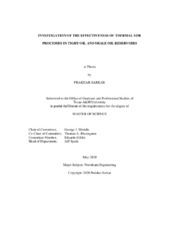| dc.description.abstract | The objective of this study is to analyze and describe quantitatively the effectiveness of thermal EOR processes in increasing production from multi-fractured unconventional resources such as shale oil and tight sand (i.e., ultra-low-permeability (ULP)) reservoirs. Specifically, this study evaluates the efficacy of conduction-based heating by circulating hot fluids through dedicated unperforated well(s) in a process that involves direct heat injection into the reservoir without concurrent injection of fluids, where the inject of fluids would be expected to cause problems of excessive pressures and adverse relative permeability regimes in these ultra-low-permeability (ULP) systems.
In this study, a non-isothermal compositional numerical simulator was developed and used to represent (a) the flow of heat by all possible transport mechanisms and (b) the flow of the three fluid phases routinely involved in these ULP reservoirs. The simulation domain is a stencil, i.e., the minimum 3D repeatable element of a hydraulically-fractured unconventional reservoir, and is discretized using a high-definition grid (to a mm-scale in some places). The solutions associated with different thermal treatments are compared to a reference case that involves a simple depressurization-induced production.
This high-resolution 3D study considers simultaneously all thermophysical processes that are affected by the changes in pressure and temperature associated with the thermal EOR operations in the ULP reservoirs, as well as their evolution over time. The rate and composition of the production stream (fluid flow), heat flow and transport by conduction and advection, phase density and viscosity, gas solubility in the liquid phases, phase changes, phase saturations and relative permeabilities are continuously monitored during the simulation process. The study captures in detail those phenomena which can be easily attenuated in coarser grids. An important part of this study is a detailed analysis of the various aspects of production affected by a thermal process, as well as the quantification of mass and energy balance and the associated losses.
The results of the study clearly indicate that the thermal processes that were considered (even those cases involving long heating periods) lead to practically negligible increases in hydrocarbon recovery that cannot even begin to compensate for the significant energy needs (and costs) of these thermal recovery methods. This work provides well-documented evidence of, and sufficient quantitative information for, the ineffectiveness of thermal processes as possible EOR method for unconventional resources, thus providing evidence that can lead to their elimination from further consideration in future applications. | en |


